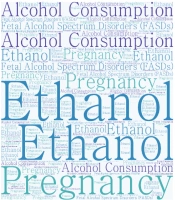Dear Editor,
Alcohol consumption during pregnancy is an increased risk behavior that raises significant clinical concerns. Ethanol is classified as a hazardous teratogenic substance (1). Possible alcohol-related defects include stillbirth, spontaneous miscarriage, premature birth, low birth weight, growth restriction, learning deficits, and some social problems later in life. In addition, numerous studies have shown that alcohol might cause more fetal malformations than cocaine, heroin, and marijuana (2).
No amount of ethanol is known to be safely consumed during pregnancy. Studies have shown that even low-level prenatal alcohol exposure can lead to invisible disabilities related to brain dysfunction, which in turn can lead to learning, memory, and behavioral problems in adulthood (1). The severity of alcohol-related effects on the fetus depends on the mother’s drinking patterns (i.e., frequency and quantity); for example, continuous moderate to high maternal alcohol consumption (binge drinking) leads to a dramatic manifestation of ethanol-related physical, mental, and behavioral retardation known as fetal alcohol spectrum disorders (FASDs) (3). Historically, much attention has been given to studying alcohol abuse disorders in men because they are more likely to drink, binge drink, and have alcohol use disorders and ethanol-related deaths than women. With psycho-socio-cultural influences, more women drink and heavily drink; accordingly, female-male differences in ethanol consumption are decreasing (4).
Today, nearly one-third of individuals with alcohol problems worldwide are female (5). In addition, ethanol consumption is rising at an awareness rate among women worldwide, especially among women of reproductive age (range: 15 - 49 years) and pregnant women (1). Globally, the estimated prevalence of ethanol use during pregnancy was around 9.8% (6).
In 40% of the studied countries, more than a quarter of pregnant women consume alcoholic drinks in excess (binge drinking) (1). In Iran, the epidemiology regarding alcohol consumption is not accurate. Iranian alcohol abusers, especially women, prefer to hide their problems. This could be due to the prevailing conservative sociocultural and religious context and the criminalization of alcohol consumption by the Islamic government (7). Some events, such as the outbreak of methanol poisoning (8) and the discovery of large quantities of illegal alcoholic beverages by the police (9), confirm the existence of clandestine consumption.
There are few studies on alcohol consumption during pregnancy in Iran. A study by Tavafian and Ramazanzadeh showed that the rate of alcohol use was 0.2% among the studied Iranian pregnant participants (10). Moreover, based on a published paper in the Lancet Global Health in 2017, Iran is one of the countries where alcohol use during pregnancy in the general population was estimated to be around < 0.5% (11).
Furthermore, a recent study by Ranjbar et al. in Iran showed that the prevalence of alcohol use during pregnancy was higher in mothers of children with physical abnormalities than in mothers with healthy children (12). This study did not investigate whether or not it was FASD-related retardation, and no other study in Iran investigated this subject. However, available data show that alcohol consumption by Iranian women of childbearing age is increasing (13). Therefore, if preventive policies are not considered, the healthcare system might face ethanol-related neonatal defects, such as FASDs, shortly that could have been previously prevented.
Prenatal and other healthcare providers must communicate an evidence-based transparent awareness to women about the risks of ethanol drinking during pregnancy, such as FASDs. Physicians should inform all women to avoid any amount of ethanol throughout pregnancy and when to decide to become pregnant, emphasizing the benefits to maternal and neonatal well-being and health. Education can come from various sources, including government guidelines, health organizations, media, and premarital education programs.
Additionally, detecting cases of ethanol use is paramount to improving maternal and neonatal health and preventing FASD cases. Screening is an effective population-based policy to reduce harmful ethanol consumption worldwide (14) and can be implemented in Iran. During each pregnancy, prenatal care providers can use ethanol screening programs and methods in their clinical care to detect prenatal alcohol exposure and reduce associated harms. To date, there have been no studies or even case reports of fetal alcohol syndrome in Iran. This letter is the first one written about fetal alcohol syndrome in Iran. The purpose of this letter was to inform and alert and make the proposal to be accepted. With this letter, the authors would like to be heard by health policymakers. The authors also would like to express their concern as health professionals about the potential risk of ethanol-related outbreaks due to clandestine alcohol use during pregnancy.
